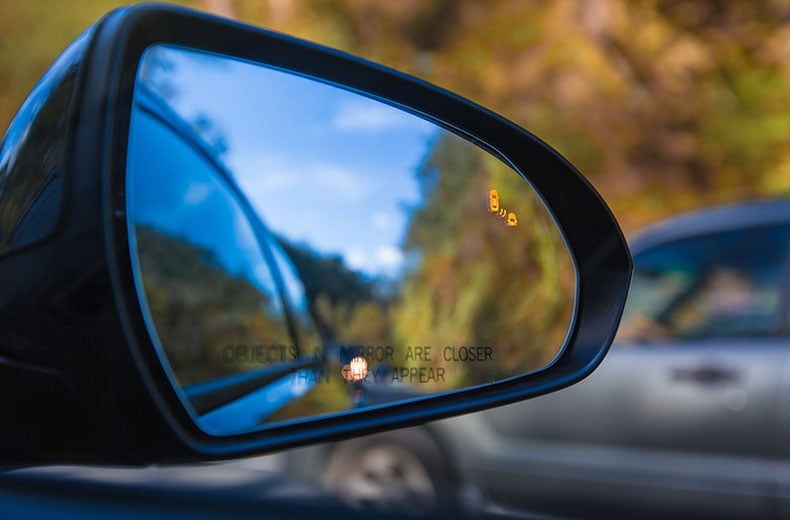Learn why it’s crucial for both experienced and novice drivers to watch their blind spots while driving, as well as why failing to do so could result in legal consequences.
What is a blind spot.
Our windows, wing mirrors, and rear-view mirrors allow us to see the area around our vehicle while we are driving.
Every vehicle has, however, some areas where mirrors have difficulty seeing. It may depend on the window size, mirror size, or position in the chair. That means you’ll have to physically turn your head to look in your blind spot, which a mirror cannot see.
The majority of vehicles have a blind spot behind the driver’s right shoulder, although the size might vary based on the type of vehicle and driving posture. You run the risk of getting into an accident if you only utilize mirrors and driving aids (such cameras or detectors) and not your own eyes and awareness of the traffic around the car.
How to check your blind spot
The action is the same regardless of the scenario. 1. Indicate
2. Inspect your mirrors.
3. By tilting your head and seeing out the window over your right or left shoulder, you can evaluate your blind spot (checking around any door frames or pillars)
4. Verify sure it is secure and clear.
5. Move with respect to people close.
When to check your blind spot
The majority of contemporary vehicles are equipped with technology to aid in this, such as a blind spot detection system that flashes a warning in your wing mirror. However, you shouldn’t rely solely on these features because it is your responsibility to always be safe and aware of your surroundings.
We set off
Check your mirrors and your blind spot by looking over your right shoulder if you are about to move away from a stop. If you’re still unsure, shut your window and check again.
This is crucial while parking in close proximity to a road. Naturally, you’ll need to look over your left shoulder to check your blind spot if you’re parked on the right side of the road.
Roundabouts and junctions
This is especially true while driving away from intersections and roundabouts where there may be traffic coming from several directions as well as other road users. Keep in aware that vehicles on motorcycles, bicycles, and foot may be passing on either side of your car. When making sure the path is clear after leaving a roundabout, checking your left blind spot can be useful.
Motorways
There are various circumstances to be mindful of if you’re currently moving quickly.
Before moving from a slip road to a motorway, dual carriageway, or significant route, check your blind spot. Some smaller vehicles may be traveling at the same speed as you in the space between the coverage of your wing mirrors and your peripheral vision out the window.
When you’re on the freeway, look in your blind spot before changing lanes. When you are certain that the route is clear, turn on your indicator, check your mirrors, and look in your blind area before merging.
Additionally, keep in mind that you can be in someone else’s blind spot when driving.
In light of this, you should exercise extra caution when driving around HGVs and other large trucks because of their increased blind spots. On the back of the car, there is frequently a sign warning that the driver cannot see anything or anyone in the blind zone. The usual phrase is “If you can’t see my mirrors, I can’t see you!”
Maintain a safe distance and pay attention to any movements or telltale signs they make in your direction. One day, a quick honk and awareness of whether you can safely merge away or retreat back could get you out of a precarious situation. serve them carefully and keep your distance.
Blind spots in pillars
An a-pillar blind spot is a region that is obscured by the vehicle’s design out of the front and/or side windows, despite the fact that the main blind spot is over the driver’s right shoulder.
An a-pillar blind spot is specifically where the windscreen meets the side windows diagonally ahead, to the left, and to the right of your field of vision.
Despite the fact that these blind areas are smaller, all drivers should be aware of what smaller cars may be hiding from their vision.
Blind spot mirrors and monitors

Despite the fact that you should constantly be conscious of your surroundings, there are devices and technology that can help you stay safe.
Blind spot mirrors, sensors, and cameras that provide you a wider vision or inform you when a car is coming are some examples of these.
When you need to quickly take your eyes from the road ahead to check your blind spot while driving, blind spot monitoring systems (BSMs), which are installed in the majority of current automobiles, can be helpful.
These are car-mounted sensors that alert the driver when a vehicle is in their blind spot by emitting an aural or visual signal (often a light on the wing mirror). The cue will be more obvious if the driver signals to move into the lane with another car in the blind area.



